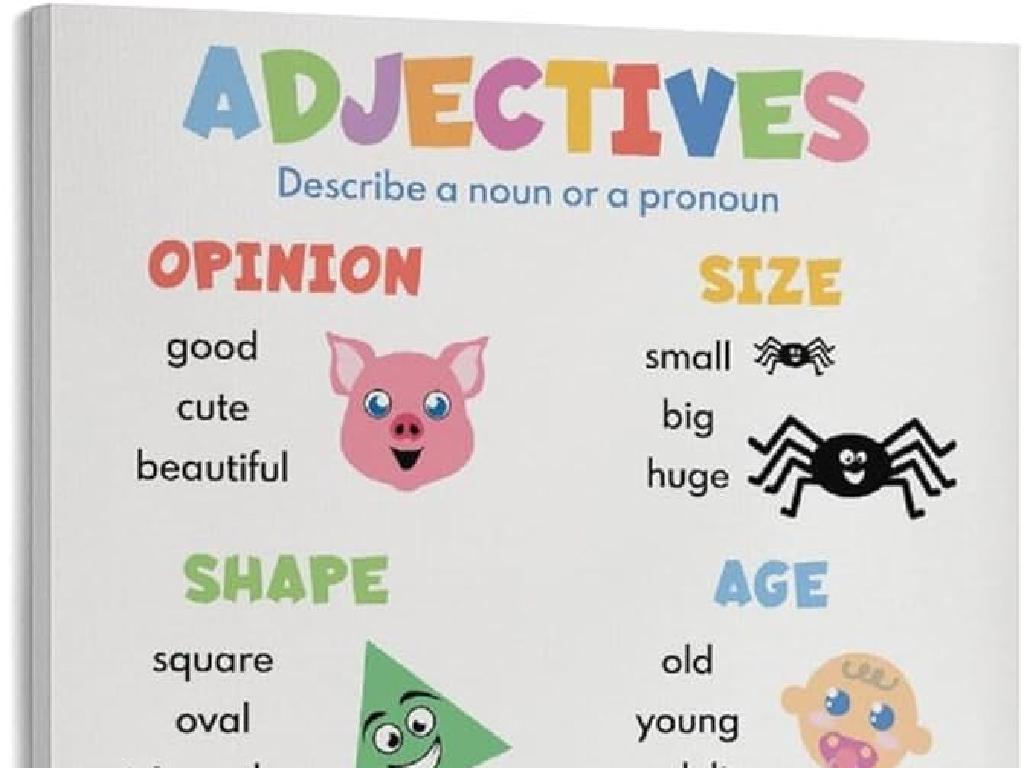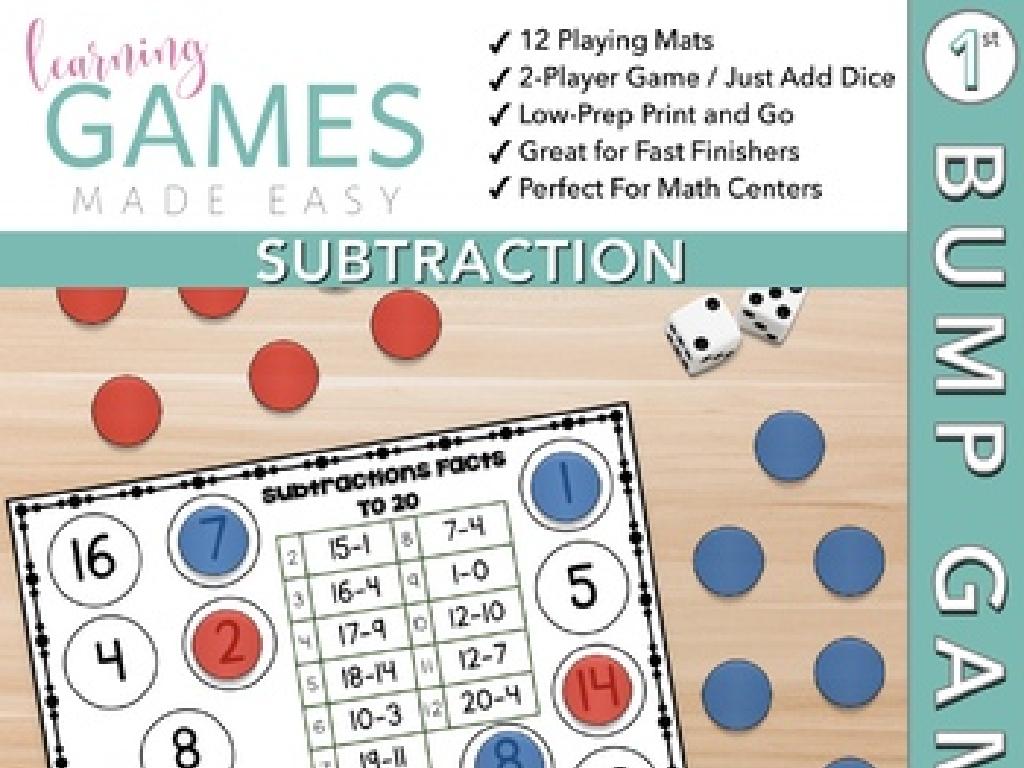Compare Objects: Length And Height
Subject: Math
Grade: First grade
Topic: Measurement
Please LOG IN to download the presentation. Access is available to registered users only.
View More Content
Welcome to Measurement: Comparing Length and Height
– Greet the class and introduce topic
– Explain comparing objects
– Comparing means finding out what’s longer or taller
– Focus on length and height
– Length is how long something is; height is how tall
– Engage with examples
– Use items in the classroom for comparison
|
Begin the class with a warm welcome and an introduction to the concept of measurement, specifically focusing on comparing the length and height of objects. Explain that when we compare, we are looking to see which object is longer or taller. Clarify the difference between length (how long something is) and height (how tall something is). Use relatable examples such as pencils, books, or even students to demonstrate the concept. Encourage the children to participate by picking objects to compare with each other. This will help them grasp the concept of measurement in a fun and interactive way.
Exploring Length: How Long Is It?
– Understanding Length
– Length measures from one end to another.
– Comparing Lengths
– Use ‘longer than’ or ‘shorter than’ to compare.
– Describing with ‘longer’ and ‘shorter’
– ‘The blue pencil is longer than the red one.’
– Class Activity: Pencil Comparison
– Which pencil is longer? Let’s find out together!
|
This slide introduces the concept of length to first graders. Start by explaining that length is a way to measure how long something is from one end to the other. Use simple language and real-life examples, like comparing pencils, to illustrate the concept. Encourage the use of comparative words such as ‘longer’ and ‘shorter’ to describe length. For the class activity, have a pair of pencils of different lengths for each student to compare and discuss which one is longer or shorter. This hands-on activity will help solidify their understanding of length comparison.
Understanding Height
– Height measures from bottom to top
– Use ‘taller’ and ‘shorter’ to compare
– Compare: Giraffe vs. Dog
– Which is taller, the giraffe or the dog?
– Activity: Measure and compare heights
– Use blocks to measure and compare objects in the classroom.
|
This slide introduces the concept of height to first graders, explaining that height is the measurement from the bottom to the top of an object. Use familiar objects to illustrate the concept, such as comparing the height of a giraffe to a dog, which they can easily visualize. Encourage the students to use comparative words like ‘taller’ and ‘shorter’ in their explanations. For the activity, provide blocks or other measuring tools for the students to measure and compare the heights of various objects around the classroom. This hands-on activity will help solidify their understanding of the concept of height.
Comparing Lengths and Heights
– How to compare objects
– Place two objects side by side to compare
– Checking the ends of objects
– The object whose end is further away is longer or taller
– Practice with classroom items
– Use pencils, books, and erasers for comparison
|
This slide introduces the concept of comparing the length and height of different objects, which is a fundamental skill in measurement for first graders. Start by explaining that objects can be compared by placing them next to each other. Demonstrate with two classroom objects, like a pencil and a marker, and show how to look at their ends to determine which one is longer. For the class activity, have a set of items ready for students to compare, such as pencils, books, erasers, and rulers. Encourage them to discuss their findings with a partner. This hands-on activity will help solidify their understanding of measurement and comparison.
Using Our Bodies to Measure
– Our bodies as measuring tools
– We can use hands, feet, or arms to measure things.
– Measure with hand spans and feet
– See how many hands or feet long objects are.
– Comparing lengths and heights
– Find out which objects are longer or taller.
– Hands-on measuring activity
– Let’s measure items in the classroom together!
|
This slide introduces the concept of using body parts as informal measuring tools, which is a practical way for first graders to understand measurement. Explain that their hand span or foot length can be used to measure and compare the length and height of various objects. Encourage the students to use their hands and feet to measure items around the classroom. This hands-on activity will help them grasp the concept of measurement in a fun and interactive way. Make sure to supervise the activity to ensure that students are measuring correctly and to answer any questions they may have. Provide guidance on how to line up their hands or feet while measuring and how to count the total to compare sizes.
Class Activity: Measure and Compare!
– Find objects to measure in class
– Use blocks for measuring
– Stack blocks end-to-end next to items
– Compare lengths and heights
– Is it longer, shorter, taller, or smaller?
– Share findings with a partner
|
This interactive activity is designed to help first graders understand measurement concepts by using a hands-on approach. Provide students with a variety of blocks and ask them to find objects in the classroom they can measure. Encourage them to work in pairs to measure and compare the length and height of different items using the blocks. After measuring, they should discuss with their partner whether the objects are longer, shorter, taller, or smaller compared to each other. Possible activities include measuring books, pencils, furniture, and toys. Ensure that each pair has enough space to work and that all students are engaged in the activity. This will help them grasp the concept of measurement in a tangible way.
Review and Share: Length and Height
– Review comparing lengths
– Show examples of longer or shorter
– Use classroom items to demonstrate
– Discuss taller or shorter items
– Compare items like pencils or books
– Share findings with the class
|
This slide is meant to consolidate the students’ understanding of length and height comparison. Start by reviewing the key concepts taught about how to compare the length and height of different objects. Encourage students to participate by asking them to provide examples of objects that are longer or shorter than others. Similarly, discuss items that are taller or shorter, and use real-life classroom items for demonstration, such as pencils, books, or even students themselves. The goal is to create an interactive environment where students can share their observations with the class, reinforcing their learning through peer examples. Prepare to guide the activity by suggesting items to compare and asking prompting questions to facilitate discussion.
Wrapping Up: Length and Height
– Excellent work today, class!
– Comparing with ‘longer’ and ‘shorter’
– Use these words to describe object lengths
– ‘Taller’ and ‘shorter’ for height
– Describe how tall things are with these words
– Practice measuring at home!
|
Today’s lesson was focused on comparing the length and height of objects using appropriate vocabulary. Reinforce the use of comparative words like ‘longer’, ‘shorter’, ‘taller’, and ‘shorter’ to help students describe and compare objects. Encourage them to practice these concepts at home by measuring and comparing various items, which will help solidify their understanding. Make sure to praise their efforts and progress in learning these new measurement concepts. For the next class, consider bringing in items for students to measure and compare as a hands-on activity.






